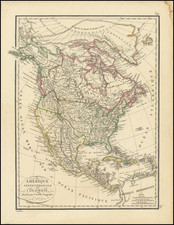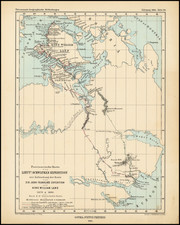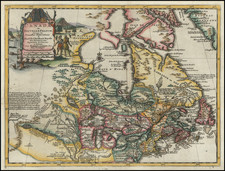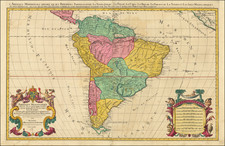Two parts in one volume. 7 (of 8) folding maps, 3 folding plates, 13 copper engravings in the text, one woodcut diagram, woodcut head- and tail-pieces and initials. (Lacking the largest folding map, as often.)
[10 preliminary leaves], 325, [5] pages, [1 leaf], 3-52 pages (i.e., textually complete).
4to, contemporary limp vellum overlaid with gilt-tooled calf backstrip and gilt red morocco lettering piece. (The backstrip probably added in the late 17th or early 18th century to standardize the spine with a collector's library. Backstrip somewhat rubbed.)
FIRST EDITION OF THIS SUPERLATIVE RARITY. ONE OF THE GREATEST BOOKS RELATING TO THE DISCOVERY AND EXPLORATION OF NORTH AMERICA.
A superbly handsome example in its original limp vellum binding of this, Champlain's relation of his four voyages to America made between 1604 and 1613.
"The volume deals very fully with the natural history of the country, its soil and products, and is especially minute in its description of the manners, customs, and habits of the Indians. In this edition the text is much fuller than in that of 1632..." (Church)
This book made manifest the mapping of the "first truly scientific cartographer of North America". The scientific exploration and mapping of New France began with the work of Samuel de Champlain, whose exceedingly rare depictions of the American Northeast are the most important and accurate 17th-century maps of the region. Champlain based his maps on his own discoveries in New France and New England in the early 1600s and published them to accompany the accounts of his voyages. His awareness of the recent English discoveries by Hudson and others to the North also allowed him to integrate, for the first time, the entire body of exploration in the region up to 1611 on a single printed map.
Champlain's explorations were the first 17th century travels to have a major effect on contemporary cartography, and they defined the direction of French explorations in the New World for the rest of the century. Champlain's "Carte Geographique de la Nouvelle Franse," is the explorer's first significant map of the vast area. Champlain penetrated farther into the interior than any previous explorer, and the geographical discoveries that can be credited to him -- and that are recorded for the first time on the large map included in this volume -- are almost too numerous to name.
Champlain's maps are also credited with initiating the mapping of the Great Lakes, and they constitute the earliest accurate delineations of the New England coastline, preceding John Smith's map by several years. Champlain had explored this region in several voyages he made as official geographer and mapmaker to New France, and his large map reaches to 40 degrees, beyond Cape Cod and Long Island, although in fact, Champlain did not travel further south than the Cape Cod and Martha's Vineyard region in his travels of 1605 and 1606 (the farthest south Champlain reached prior to publication of the maps). These discoveries preceded the important voyage by Captain John Smith and Adrian Block.
This is the second book published by Champlain, following his first publication covering his voyage of 1603, which was entitled: Des sauvages, ou Voyage de Samuel Champlain, de Brouage, fait en la France nouvelle l'an mil six cens trois. That book, which was published in Paris in 1603, is completely unobtainable.
The book includes the following maps and charts, all of them copperplate engravings:
- Carte geographique de la/ Nouelle franse en son vray meridiein. 255 x 335 mm. Burden 161.
- Chouacoit-R. 115 x 160 mm. Burden 166.
- Isle de sainte Croix. 150 x 250 mm. Burden 167.
- le Beau port. 150 x 245 mm. Burden 168.
- le grand sautl st. louis. 115 x 165 mm. Burden 169.
- Malle Barre. 150 x 240 mm. Burden 170.
- port au mouton. 110 x 160 mm. Burden 171.
- Port de la heue. 110 x 160 mm. Burden 172
- Port des mines. 110 x 160 mm. Burden 173.
- Por du Rossÿnol. 110 x 160 mm. Burden 174.
- port. fortuné. 150 x 240 mm. Burden 175.
- port Royal. 150 x 245 mm. Burden 176.
- Port St Louis. 105 x 145 mm. Burden 177.
- Quebec. 150 x 245 mm. Burden 178.
- qui ni be quy. 115 x 160 mm. Burden 179.
- R du Saguenay/ B.port de tadoucac. 115 x 160 mm. Burden 180.
- R. st lehan. 120 x 160 mm. Burden 181.
Carte geographique de la/ Nouelle franse en son vray meridiein.
The present book includes the highly important general map of eastern Canada and New England, described by Burden thusly:
This very rare map accompanies the second published work of Samuel de Champlain in 1613. Heidenreich and Dahl argue that it was almost certainly prepared the previous year. Champlain had been in France since September 1611. Accompanying this map in the book were a large two sheet map concentrating on the St. Lawrence River (see the previous entry for more background information), and numerous small charts. Although these were probably all the work of David Pelletier, this map quite clearly has a different engraver. The contents of the book vary and the larger map is often wanting . Probably after finishing the larger map Champlain acquired knowledge of Hudson's discovery of the Bay named after him . This would undoubtedly y have been Hessel Gerritsz's work published in Amsterdam, 1612. Seeing the possibilities this could provide he had this map drawn up on a larger scale to incorporate the new bay.
A true bibliophile's example of one of the cornerstone works in the history of exploration.











![Amerique Septentrionale divisee en Ses Principales parties . . . . 1674 [Rare First State]](https://storage.googleapis.com/raremaps/img/small/99317.jpg)


